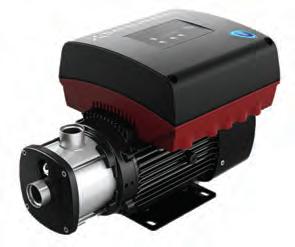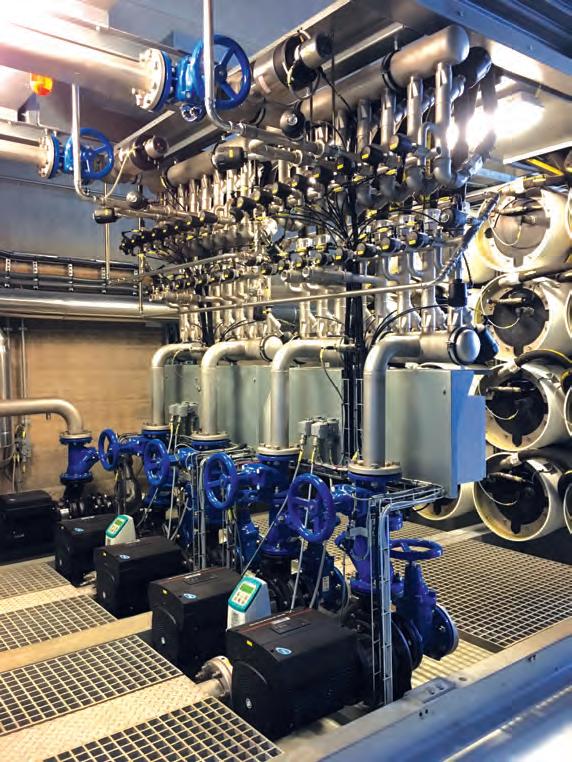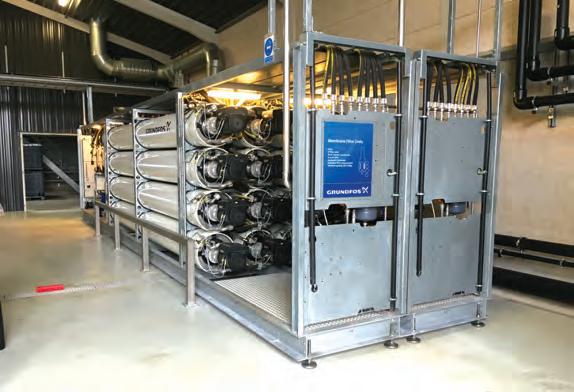
5 minute read
The way Forward for Pumps in F&b
Pumps play a major role in food and drink processing, as many machines require these for operation. Pearly Neo spoke to Grundfos’ Eric Lai about how pumps are expected to evolve moving forth.
What are some of the current major
roles that pumps play in terms of food processing and/or packaging?
The food and beverage (F&B) industry consists of a wide range of processes and applications that call for pumps to keep things moving during the production process, from the processing of raw materials to the hygienic transport of fi nished products. Pumps are prevalent across all food processing plants, confectionery and chocolate factories, as well as dairies.
For the dairy industry, hydraulic pumps are used to keep milk and other dairy products fresh and free of cross contamination, while sanitary pumps ensure the pasteurisation process is free from bacterial contamination. For chocolate and confectionery, pumps are necessary for process control, strict temperature control and the precise handling of solids. With other processed foods, pumps come into play to ensure constant motion for food mixtures with high viscosity.
Pumps are also used in every facility in the industrial water circuit, which includes ensuring a stable water supply, leading wastewater out of the plants to treatment facilities, and circulating water throughout the facilities for heating and cooling applications.
Eric Lai
In chocolate manufacturing, pumps can help to manage temperature control so as to maintain optimum processing conditions.
How crucial a role do pumps play with regard to establishing true 'factories of the future', and what sort of changes/transformations do you feel need to be highlighted to industry players in order to move towards this?
‘Factories of the future’ call for more effi cient, greener processes, and the production of more customised and higher quality products. Industries in turn need to make the necessary transition towards a more demand-driven approach, with less waste and a better use
of resources.
For industries, pumps are involved in every part of the manufacturing process, accounting for up to 25 per cent of energy usage in certain industrial plant operations, as per numbers from the US Department of Energy. Thus, in order for industries such as F&B to future-proof themselves, they need to look at the latest pump technology and innovations that can take their manufacturing processes to the next level, including tapping into the Internet of Things and adaptable machines.
It appears that digitalisation is one of the major factors of discussion in F&B. What sort and how big of a role does digitalisation play in the Asian F&B industry?
Food manufacturing companies have been dealing with various challenges over the last few years, namely the volatile market demand and changing requirements from customers as well as suppliers, which have been driving the move towards ‘factories of the future’, or Industry 4.0.
As concerns over food safety grow rapidly in Asia, digital technology in the F&B industry is crucial in not only ensuring datadriven transparency throughout the manufacturing process, but also ensuring quality control and the strictest of hygiene standards.
With food innovation taking off to meet changing consumer tastes, the production process could look to include automated and adaptive technology to accommodate a wide range of raw materials while still maintaining the consistency and integrity of food products.

With digitalisation addressing some of the key issues in the traditional manufacturing process, intelligent applications such as adaptive pump technology mean increased effi ciency and a more effective use of resources. This leads to the ability to intelligently control energy consumption by keeping the use of a pump to a bare minimum. These applications mean that the F&B industry has the potential to generate maximum output with a minimum use of resources.
What are some of the recent challenges particularly relating to pumps that the F&B industry has faced, that have been successfully navigated with the use of intelligent solutions?
Digitalisation is key to addressing the various challenges that exist in a traditional manufacturing process, making it more effi cient and sustainable.
For example, when it comes to the handling of delicate or sensitive products in the food and beverage industry, Grundfos’ smart pumps are able to intuitively adjust their speed and performance in response to changes in the product's properties. This ensures gentle handling during processing and effi ciently prevents the product from being physically damaged. This in turn makes for less waste and higher yield.
For products like chocolate and confectionery that are sensitive to heat, these pumps are also able to adapt to changes in temperature based on feedback from sensors, ensuring that any potential temperature increase due to handling can be kept at a minimum so as to maintain optimum processing conditions. There is no limit to how far pumps will be able to evolve in the industry.



What sorts of issues/concerns do you commonly come across when it comes to implementing these new solutions?
While the food manufacturing industry has made great strides in switching to newer technology, adoption is still a challenge. What companies need to realise is that while advanced intelligent technology can cost more upfront, the benefi ts in the long run will exceed the upfront investment. As these innovations are further developed on a larger scale and with affordable distribution, cost will be less of a barrier in the near future.
How do you foresee digitalisation changing the industry moving forward, and what does the future hold for digitalisation in F&B?
Moving forward, the food industry will demand faster processes – machines that give manufacturers the fl exibility to be more agile in the production process and more reactive to retail changes in real time. This means processing innovation that focuses on cleanability, fl exibility in changeover and operator safety.
What about pumps in particular – what do you see will be the 'end point' of evolution for pumps, i.e. what will the 'perfect' pump be able to do at the end of the day?
Like with any other technology, there is no end point in terms of the evolution of pumps, as new challenges and issues develop along the way, as well as greater innovation. This is exciting for the pump industry as it means continuous improvement and keeping things competitive to stay ahead of the game to provide industries what they need.










